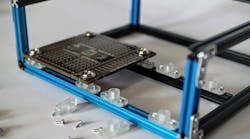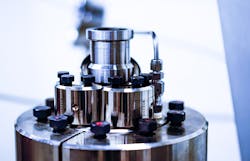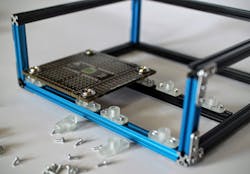This article is full of advice from my engineering experiences devising and constructing fixtures and test equipment for research and production. Perhaps in your position, you are called on less frequently or maybe not at all to design and construct engineering apparatus. No matter, the advice presented here can also be used when making decisions about selecting materials for a design.
Someday soon, a host of new materials will be available for us. Unfortunately, for now, they remain experimental or the province of extremely specialized applications and processes. So, until we can buy a 3D printer that prints nigh indestructible objects out of pure graphene, we will just have to settle on what’s available to us.
I have witnessed a disturbing number of professionals kluge together fixtures and equipment out of conduit, hacked up blocks of wood, nails and glue. This is not an exaggeration. If you need to hold up the corner of a machine, then, by all means, use the block of wood but otherwise don’t take queues from the ad-hoc school of design.
What you produce represents you and your abilities. You will be judged on the amount of company money you spend and the efficacy of the final product. Also, whether anybody admits it or not, you are going to be judged on the appearance of the final product. Ramshackle atrocities held together with epoxy and double sided tape don’t exactly advertise competency.
There will always be occasions that will demand very specialized and difficult to work materials, and this is when you must rely on an outside vendor. The rest of the time, so much can be tackled with a collection of easy-to-work-with materials. The types of materials I keep on hand are typically easy to work, strong and inexpensive. You are trying to accomplish as much as you can as fast as you can while spending as little company money as possible. Even if you have the tools and expertise to work with a difficult material like titanium rod, why do it unless absolutely necessary.
6061 Aluminum
6061 is truly the workhorse of aluminum. Compared to all other aluminum alloys, it has about the best balance between cost, machinability and strength. It is very easy to work and is free-machining. You can even “fit” 6061 parts by shaving it down with a hobby knife.
7075 Aluminum
It is as strong in the tensile as some mild steels. It is also amazingly rigid for aluminum. In fact, I often use 7075 shafts for testing in place of steel shafts. While not quite as free-machining as 6061, it machines beautifully. It does cost approximately twice as much as 6061, so it may not be your first choice for aluminum. It is hard enough that you won’t be trimming it with a blade like you can do to 6061.
Extruded Aluminum Profiles
Sometimes called T-slot extrusions, these specially shaped aluminum bars manufactured via the extrusion process. They can be cut to length and assembled into just about any configuration you need. Extruded profiles are like the engineer’s erector set. Because they are made of aluminum, they are easy to cut, and because of their shape, they are extremely adaptable. Just add parts and accessories to them as needed. Whenever possible, I use aluminum profiles for the skeleton of machines and fixtures because I know that if something needs to be changed or added later, it won’t be a problem. Once the useful life of a fixture has run its course, just take it apart and use the profiles for something else. Learn to use extrusions. They save a lot of time and money, and the end result is almost always very professional looking.
The smaller-dimension profiles are perfect for building frameworks for screens, sensors, and single board computers. If you intend to construct something involving robotics, the small profile extrusions are a great place to start.
For assemblies that require greater mass and rigidity than the smaller profiles can offer 80/20 aluminum extrusion is available in a large variety of configurations and sizes. It is strong enough that you can even make desks, carts, shelves and as shown on the 80/20 website, chairs.
POM (AKA polyoxymethylene, Acetal and sometimes Delrin)
POM/Acetal and Delrin are not always the exact same material, but they are so similar as to be indiscernible for most purposes. Wherever plastic is needed, try to use POM. It absorbs very little moisture, is chemically resistant to just about everything and is just about the easiest machining material you can get. You also won’t find a better performing plastic for the price. If your parts are meant to come into contact with alcohol or fuel, then POM is a great choice. It can handle years of exposure to fuel. POM is also very strong and can sometimes take the place of metal components. The one issue with acetal is that is it ferociously difficult to bond together. Special processes are required to do this successfully, so you will have to rely on mechanical fastening. There are adhesives available that claim to be able to bond acetal but I have never witnessed them yield anything approaching a useful result.
Turcite
Turcite is a form of PTFE (Teflon) that has been doped with other materials. Typically, red or turquoise it is great for linear bushings or machine gibs because it has a very low coefficient of friction. With careful attention to preparation, Turcite can be bonded to metal with the appropriate adhesives. Turcite machines almost exactly like acetal, that is to say, extremely easily. Turcite is preferable to use instead of PTFE because its higher rigidly allows it to be worked more easily. PTFE is sometimes too soft and gummy to easily work with.
Nylon
The mechanical properties and chemical resistance of nylon are pretty dismal next to POM. It does not machine nearly as well either. Moreover, it absorbs an alarmingly high amount of moisture. However, unlike POM, nylon can easily be bonded together. This one property makes it is worth keeping a bar or two of it around.
HDPE Sheets
If you need a rigid sheet of plastic, then consider high-density polyethylene sheets (HDPE). In sheet form, it is typically far less expensive than other types of plastics. It is also extremely easy to work with hand tools. The utility of HDPE sheets does not carry over to bars of the material. While HDPE rods are very inexpensive, they have pretty meager mechanical properties. If you need a rod of plastic, go with acetal instead.
G10 (AKA Garolite)
G10 is a material made from layers of fiberglass cloth bonded together under pressure with epoxy. G10 isn’t something that you would use just anywhere and compared to the other materials on the list; it is expensive.
However, when constructing a bed-of-nails type of text fixture, garolite makes a great base for pressing in pogo-pins. The pins have a tendency to pop out of holes in plastic because there isn’t enough friction to keep them in place. Garolite is easy to drill but because the dust is an inhalation hazard so wear a particulate filter mask when working the material.
Machinist Wax
Sometimes called prototyping wax, it can be worked very easily by hand or machine into a desired shape. The wax can then be re-melted back into a single billet. Because of its reusability, a single rod can last a really long time. You just need a small electric hot plate and a double boiler to reform the wax. More useful than its extreme workability is its use as a method of work holding or work support. If you have a particularity delicate part to work on, drop it partially into some molten wax. When the wax hardens, you now have a sacrificial feature to clamp onto.
The part can then be removed by simply dropping it, and the wax, into hot water.
If you are machining or drilling a very thin wall part, fill it with wax. The wax supports the part against deformation, while you work on it. If you are experiencing a lot of chatter when boring in a lathe, fill the part with wax. It is so soft that the boring bar will cut through it almost like it isn’t there, and the wax will prevent the part from ringing and creating a chattered surface. A quick stand-in for machinist wax is paraffin wax. You can find it in grocery stores next to the glass jars for canning.
Stainless-Steel Fasteners
Unless you really need the tensile strength of a particular steel, stick with stainless steel fasteners. Stainless cost more, but it is totally worth not having to struggle with rusted screws later on. Of course, this is not always possible when you are trying to manufacture a product as cheaply as possible.
Steel
Avoid steel and stainless steel unless you really need it. Steels take longer to work and wear out tools much quicker than softer materials. If you must work with steel, get something that is free-machining steel like 1215. If you need a stainless steel, use 303. It is less difficult to drill cut and tap than 304 and many other grades.
Conclusion
For most situations, I find myself reaching for 6061 aluminum and acetal. Save your scrap materials, the cut-offs and the failed parts. Get a file cabinet and load each drawer with a different material. Those leftovers may be handy later as sacrificial pieces are the basis for another part. Avoid tape and excessive use of adhesives. Too many times I have seen people epoxy parts together. Then when something needed to be changed or repaired, the assembly had to be cut open.



